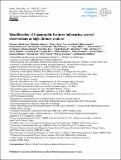Por favor, use este identificador para citar o enlazar a este item:
http://hdl.handle.net/10261/173821COMPARTIR / EXPORTAR:
 SHARE SHARE
 CORE
BASE CORE
BASE
|
|
| Visualizar otros formatos: MARC | Dublin Core | RDF | ORE | MODS | METS | DIDL | DATACITE | |

| Título: | Identification of topographic features influencing aerosol observations at high altitude stations |
Autor: | Coen, Martine Collaud; Pandolfi, Marco CSIC ORCID; Ruffieux, Dominique C. | Palabras clave: | Nucleation Aerosoles Formation events |
Fecha de publicación: | 24-ago-2018 | Editor: | Copernicus Publications | Citación: | Atmospheric Chemistry and Physics 18 (16) 24: 12289-12313 (2018) | Resumen: | High altitude stations are often emphasized as free tropospheric measuring sites but they remain influenced by atmospheric boundary layer (ABL) air masses due to convective transport processes. The local and meso-scale topographical features around the station are involved in the convective boundary layer development and in the formation of thermally induced winds leading to ABL air lifting. The station altitude alone is not a sufficient parameter to characterize the ABL influence. In this study, a topography analysis is performed allowing calculation of a newly defined index called ABL-TopoIndex. The ABL-TopoIndex is constructed in order to correlate with the ABL influence at the high altitude stations and long-term aerosol time series are used to assess its validity. Topography data from the global digital elevation model GTopo30 were used to calculate five parameters for 43 high and 3 middle altitude stations situated on five continents. The geometric mean of these five parameters determines a topography based index called ABL-TopoIndex, which can be used to rank the high altitude stations as a function of the ABL influence. To construct the ABL-TopoIndex, we rely on the criteria that the ABL influence will be low if the station is one of the highest points in the mountainous massif, if there is a large altitude difference between the station and the valleys or high plains, if the slopes around the station are steep, and finally if the inverse drainage basin potentially reflecting the source area for thermally lifted pollutants to reach the site is small. All stations on volcanic islands exhibit a low ABL-TopoIndex, whereas stations in the Himalayas and the Tibetan Plateau have high ABL-TopoIndex values. Spearman's rank correlation between aerosol optical properties and number concentration from 28 stations and the ABL-TopoIndex, the altitude and the latitude are used to validate this topographical approach. Statistically significant (SS) correlations are found between the 5th and 50th percentiles of all aerosol parameters and the ABL-TopoIndex, whereas no SS correlation is found with the station altitude. The diurnal cycles of aerosol parameters seem to be best explained by the station latitude although a SS correlation is found between the amplitude of the diurnal cycles of the absorption coefficient and the ABL-TopoIndex. © 2018 Author(s). | Versión del editor: | https://doi.org/10.5194/acp-18-12289-2018 | URI: | http://hdl.handle.net/10261/173821 | DOI: | 10.5194/acp-18-12289-2018 |
| Aparece en las colecciones: | (IDAEA) Artículos |
Ficheros en este ítem:
| Fichero | Descripción | Tamaño | Formato | |
|---|---|---|---|---|
| Identification of topographic features influencing aerosol.pdf | 3,03 MB | Adobe PDF |  Visualizar/Abrir |
CORE Recommender
SCOPUSTM
Citations
30
checked on 21-abr-2024
WEB OF SCIENCETM
Citations
22
checked on 23-feb-2024
Page view(s)
201
checked on 23-abr-2024
Download(s)
348
checked on 23-abr-2024
Google ScholarTM
Check
Altmetric
Altmetric
NOTA: Los ítems de Digital.CSIC están protegidos por copyright, con todos los derechos reservados, a menos que se indique lo contrario.
